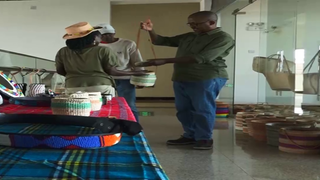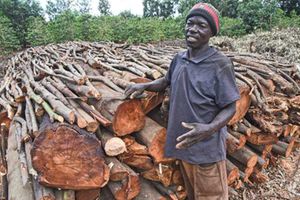
Residents David Tayo and Marcy Mariko show their products at Miasenyi Standard Gauge Railway (SGR) station, in Taita Taveta County. The station was constructed to tap into tourism due to its proximity to Tsavo East National Park.
| BILL OTIENO| NMGTaita Taveta
Premium
How locals discovered unexploited market in SGR stations
What you need to know:
- Miasenyi Standard Gauge Railway (SGR) station, Taita Taveta County was constructed to tap into tourism due to its proximity to Tsavo East National Park.
- A few entrepreneurial locals have since realised this and taken it upon themselves to create opportunities that they hope will lift their livelihood.
It is about 10 minutes to 9am at Miasenyi Standard Gauge Railway (SGR) station, Taita Taveta county and very little activity is happening with just four people seated eagerly waiting to board a 9.12 am train to Nairobi.
The third station from Mombasa after Mariakani paints a different picture from what is seen in other eight stations which are now marking six years since Madaraka Express, operated by Kenya Railways Corporation (KRC) in conjunction with Afristar was launched.
Unlike other stations which witness a lot of movement and activities with tens of taxis ready to pick passengers, at Miasenyi station, there is hardly any car.

Miasenyi Standard Gauge Railway (SGR) station, Taita Taveta County. A few entrepreneurial locals are seizing the opportunity brought by increased tourists by selling gemstones, kiondos and artifacts.
The situation has been frustrating to locals who had high expectations that the station will improve the area’s economic activities.
“We rarely get business from the station because of its location. Today I was called by a passenger to pick him up from the station. That is why I am here today. I rarely come here since there is no business and last time I was here it was about three weeks ago,” said Andrew Jomo, a bodaboda rider at Miasenyi.
Unknown to many locals, this station is not an ordinary one. Unlike the rest, it was constructed to tap into tourism due to its proximity to Tsavo East National Park.
A few entrepreneurial locals have since realised this and taken it upon themselves to create opportunities that they hope will lift their livelihood.
KRC managing director Philip Maingi said all railway projects are usually strategically placed and in the case of Miasenyi, it is servicing the tourism sector well in the area.
He conceded that initially, the station had challenges with numbers but tourism has picked up especially after the Covid-19 pandemic.
“The station has enough numbers and in future it will be ideal for government projects,” said Mr Maingi, when touring a Mombasa railway project last week.

Kasigau women weaving baskets which they then sell to tourists at Miasenyi Standard Gauge Railway (SGR) station, Taita Taveta County.
The local business community confirmed that most of the commuters boarding the train here are tourists.
Today a section of the Voi business community have occupied stalls in both the Voi and Miasenyi stations, selling value added gemstones and traditional artifacts sourced from locals. Such products are often loved by tourists.
Davis Tayo, one of the traders who saw a niche market at the SGR stations, sources raw gemstones from the locals and produces high end ornaments for the market.
While displaying them for commuters using the SGR train, he tells me that the Miasenyi train is uniquely significant to his business since it is the only station next to the National Park exit. Tsavo Bachuma gate and SGR are adjacent to each other.
According to Tayo, the majority of the products displayed are sourced from locals and labeled with their names and contacts.
This allows the buyer to call the producer if they are satisfied or dissatisfied with the product, a decision that was made to boost the local economy.
“There is a particular basket which was bought for Sh4,500. A woman was passing by and she liked it That brought a lot of joy in our hearts” Tayo added.
Mercy Mariko is another trader who got business opportunities at the SGR station.
“We consider this a strategic place where it is easier to market our products,” she says.
Apart from gemstones, other products available are woven baskets, table mats, hats among others.
Nation.africa visited a group of local women where some of the products are made.
To them, the SGR market is a blessing since they inherited basket weaving prowess from their parents yet there was no market.
“We love our work because we inherited the skills from our forefathers,” said Hilda Mbuwa, a local in Kasigau.
The County Government have is supporting the women groups by offering Value addition training.
“Apart from setting aside a place for them to sell viondo, we will be opening up another place where they can sell their artifacts,” said Gloria Monikombo, the County Executive Committee Member for Education in Taita Taveta.

Baskets for sale at Miasenyi Standard Gauge Railway (SGR) station, Taita Taveta County. The products are labeled with the local producer name and contacts.
In the KRC Master Plan, the Miasenyi station was also meant to serve two key facilities which were to be constructed a few kilometres away but the projects have not begun.
The station was meant to serve the Bachuma dry port where an Export Processing Zone was to be constructed and also be used to ferry livestock from the nearby animal holding ground.
The SGR is a flagship project of the Kenyan government under the Vision 2030 development agenda. It is the largest infrastructure project since the country attained independence in 1963.
The project is aimed at simplifying transport operations between Nairobi and Mombasa and plans are underway to expand the project to other towns in East Africa.
In an economic survey report released in 2022, the Kenya National Bureau of Statistics said earnings from the Madaraka Express more than doubled to Sh2.2 billion in 2021 after passengers increased from 806,000 in 2020 to 1,933,000 in 2021.





